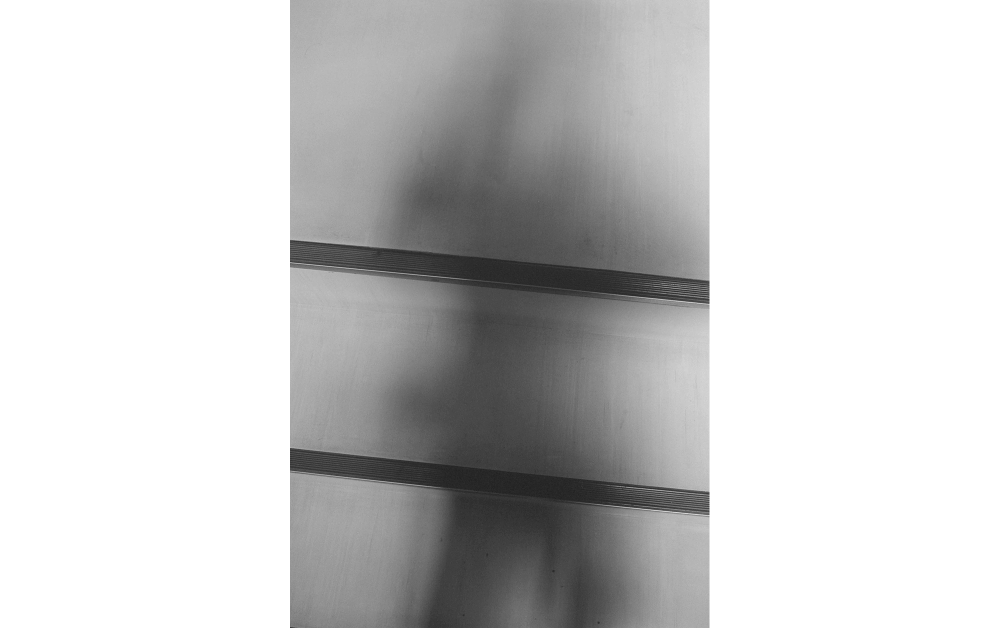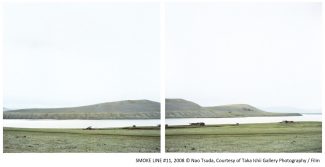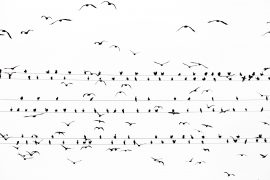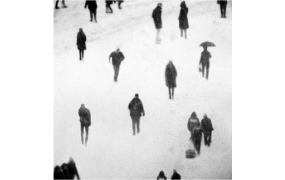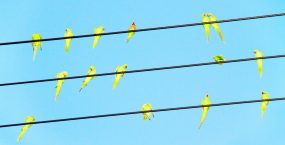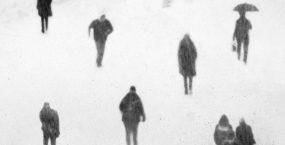On exhibit are two bodies of work by Ryudai Takano. On the far wall, gelatin-silver prints enlarged from 35mm negatives are images of the photographer’s shadow. Barely perceptible, the photographer’s form casts a faint silhouette on the floor. On the wall immediately to the left, three photograms* comprise one work. This too is an image of the photographer’s silhouette. Takano exposed the three photograms simultaneously by positioning the photo-sensitive sheets in one corner of a darkroom.
On the opposite wall, the work of Nao Tsuda is presented in a vertical alignment, extending the horizon line of the landscapes. Each of the four works are comprised of two panels whose frames overlap slightly. This overlap suggests how the eyes see if they were individual cameras. Tsuda’s images were shot in three remote locales: Huangshan in China, valleys and deserts in Morocco, and the northern part of Mongolia. Even if the exact locales are unnamed, the spots where Tsuda chose to place his tripod are specific and chosen based on a sequence of chance encounters during his journeys. In his journey to meet those who live with the winds, Tsuda learned that there is a kind of “wind streams” that extends around the globe, connecting distant places.
Pairing the photography of Takano and Tsuda is a study of contrasts. Both photographers capture phenomena that are neither concrete nor abstract but something in-between. Neither photographer manipulates the conditions of the shoot or the images that are generated. In other words, both are using “straight photography” yet their approach is conceptual. Takano’s work was shot within the confines of a room, which is a recurrent motif in his work. He often uses “my room” as a place for photography even though little to no personal information is revealed. On the other hand, Tsuda’s work is all shot outdoors in far-flung, remote locations that were accessed by happenstance. Tsuda’s camera points toward something mystic and asserts photography’s ability to capture it.
Both photographers, within exceedingly refined choices and restricted parameters, express creativity and depth. They show that photography is ultimately no more than a process of recording shadows. These works are a consideration of the triangular relationship between photographer, camera, and image, or, in this case, the shadows of perception.
*A photogram is the exposure of photo-sensitive paper without the use of a camera. Whatever object is between the paper and the light source becomes recorded as a white shape.
― Ivan Vartanian Director, the amana collection
【About the amana collection】
the amana collection represents the excellence of contemporary Japanese photography. Begun in 2011, the collection is comprised of approximately nine hundred exhibition prints thus far, representing a broad cross-section of approaches and methodologies.
the amana collection brings together the work of those photographers who question our established ways of thinking and seeing in order to clear the way for the new. the amana collection is committed to supporting the efforts of Japanese photographers by raising the awareness and understanding of their photography.
| Title | 「the amana collection Exhibit 04: Ryudai Takano, Nao Tsuda」 |
|---|---|
| Dates | Monday 2 September, 2019 – Monday 30 September, 2019 |
| Site | IMA gallery(Tokyo) |
| Time | 11:00 – 19:00 |
| Closed | Sundays and National Holidays |





